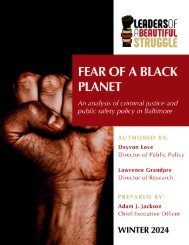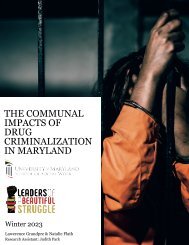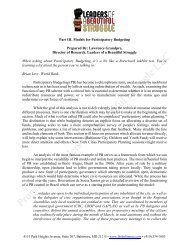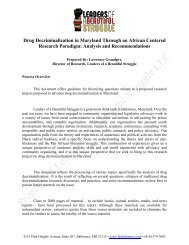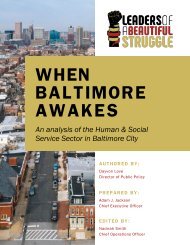Workforce Development Legislation and Practice Literature Review, Maryland, 2007-2017
This document attempts to create an overview of the literature around the legislative and political dynamics around workforce development theory and practice in Maryland through the years 2007 through 2017. This period includes three different gubernatorial regimes, three presidents, a massive shift in federal workforce development policy, and the largest economic contraction in the United States since the great recession. While the tumultuous circumstances this time period encompasses adds an additional layer of complexity to an already diverse state workforce environment, over time general trends can be observed and evaluated
This document attempts to create an overview of the literature around the legislative and political dynamics around workforce development theory and practice in Maryland through the years 2007 through 2017. This period includes three different gubernatorial regimes, three presidents, a massive shift in federal workforce development policy, and the largest economic contraction in the United States since the great recession. While the tumultuous circumstances this time period encompasses adds an additional layer of complexity to an already diverse state workforce environment, over time general trends can be observed and evaluated
You also want an ePaper? Increase the reach of your titles
YUMPU automatically turns print PDFs into web optimized ePapers that Google loves.
development boards, with the GWDB being one of the few entities able to span across all these levels.<br />
The literature reveals the importance of adopting a holistic view of the states workforce efforts in order to<br />
properly underst<strong>and</strong> how workforce development functions.<br />
The literature also reveals some of the limitations of the state’s current efforts around workforce<br />
development. While the efforts appear to be in a period of flux given the continued implementation of the<br />
new federal law, the literature reveals that certain aspects of how workforce developments appear to<br />
happen in practice are difficult to discern from the literature. In the only directly comparative document<br />
in the literature, the joint report done comparing regional WIOA implementation plans, a constant refrain<br />
noted throughout the report was that, while Maryl<strong>and</strong>’s plan was generally given credit for being solid, is<br />
was also noted for being relatively vague, lacking specific are critical areas in implementation. Indeed,<br />
some of the essential information about how workforce development boards operate in practice,<br />
information for example related to the curriculum used in workforce development programming, <strong>and</strong><br />
participant evaluations of their experience in workforce development programs, was beyond the scope of<br />
this literature review <strong>and</strong> largely unavailable in this time period.<br />
Correcting this lack of information becomes especially critical when the literature around Maryl<strong>and</strong><br />
workforce development is analyzed from a racial equity st<strong>and</strong>point. While there is a consistent discussion<br />
of including marginalized populations <strong>and</strong> those excluded from traditional pipelines to employment, the<br />
vast majority of the literature fails to address the root causes behind the exclusion of vulnerable<br />
populations from the workforce. With notable exceptions, the literature fails to ask fundamental questions<br />
about racial equity. This is perhaps most clearly exemplified by the GWIB’s list of questions discussion<br />
around WIOA implementation. While the institution presented over 50 very specific questions about the<br />
transition in federal law with 10 distinct subgroups, questions specific to the law's impact from an equity<br />
perspective are notable in their absence. When the literature is examined from an equity perspective,<br />
efforts which appear to be perfectly rational <strong>and</strong> perhaps even progressive are questionable in terms of<br />
their equity impact. For example, when the state legislature exp<strong>and</strong>s licensure requirements to barber<br />
services, this appears to be another opportunity for workforce development, with services being deployed<br />
to get individuals certified in their fields. Yet growing bodies of equity-based literature around licensure<br />
regimes show that in many cases these licensure regimes create a bottleneck where individuals are forced<br />
to go through lengthy <strong>and</strong> potentially expensive training programs for employment opportunities where<br />
the very need for licensure is questionable, a burden found to disproportionately impact people of color. 49<br />
As such, the Skills2Compete initiatives focus on middle-skill jobs where professional licensure rather<br />
than a four-year degree may need to analyzed more deeply to ensure that the licensure regimes themselves<br />
are not barriers to employment. Additionally, one of the recommendations of MCCEI report, around the<br />
development of a new construction management program at a Maryl<strong>and</strong> university, risks duplicating<br />
existing programs at one of the state’s historically Black colleges, a practice which is against state law<br />
49<br />
Rodriguez, Michelle Natividad, <strong>and</strong> Beth Avery. “Unlicensed & Untapped: Removing Barriers to State Occupational Licenses<br />
for People with Records.” Report, National Employment Law Project, 26 Apr. 2016, www.nelp.org/publication/unlicenseduntapped-removing-barriers-state-occupational-licenses/.<br />
4151 Park Heights Avenue, Suite 207, Baltimore, MD 21215 • www.lbsbaltimore.com • (410) 374-7683




